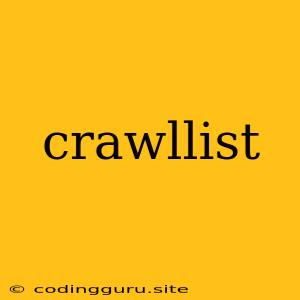Understanding Crawl Lists: A Guide to Web Scraping and Data Extraction
Have you ever needed to collect data from a large number of web pages? Perhaps you're researching market trends, gathering product information, or analyzing social media sentiment. In these scenarios, manually visiting each website and extracting data would be an incredibly tedious and time-consuming process. That's where crawl lists come in.
Crawl lists are essential tools for efficient web scraping and data extraction. They act as a roadmap for your web scraper, telling it exactly which web pages to visit and in what order. This allows you to automate the process, saving you hours of manual effort and ensuring that you gather the data you need in a structured and organized manner.
What is a Crawl List?
A crawl list is a structured list of URLs that you want your web scraper to visit. It's like a to-do list for your scraper, guiding it through the web pages you want to extract data from.
Crawl lists can be created in several ways, including:
- Manually: You can manually create a crawl list by adding each URL one by one. This is suitable for smaller projects or when you have a specific set of URLs you want to target.
- Using a seed URL: You can provide a single seed URL, and the scraper will then follow links on that page to discover new URLs to add to the crawl list. This is helpful for crawling large websites with a hierarchical structure.
- From a file: You can import a list of URLs from a file, such as a CSV or text file. This is particularly useful when you have a large number of URLs that you need to crawl.
Why are Crawl Lists Important?
Crawl lists play a crucial role in effective web scraping for several reasons:
- Organization: They ensure that your scraper follows a defined path, preventing it from getting lost in a maze of web pages.
- Efficiency: By providing a clear set of targets, crawl lists help your scraper focus its efforts and maximize data extraction speed.
- Control: You have complete control over the websites and specific pages your scraper visits, ensuring you only collect the data you need.
- Avoidance of Duplicate Data: Crawl lists help prevent your scraper from visiting the same web page multiple times, eliminating redundant data collection.
- Compliance: They are essential for staying compliant with website terms of service and avoiding being blacklisted by websites for excessive crawling.
How to Create a Crawl List
Creating a crawl list involves defining the scope of your scraping project and selecting the URLs you want to target. Here's a step-by-step guide:
- Define your target websites: Start by identifying the websites you want to scrape data from.
- Identify the URLs: For each website, determine the specific pages you want to target. This might involve landing pages, product pages, blog posts, or any other relevant web pages.
- **Structure your crawl list: Depending on your scraping goals, you can organize your crawl list in different ways:
- Sequential: Visiting URLs in a specific order.
- Hierarchical: Following links from a seed URL to explore the website's structure.
- Random: Visiting URLs in a random order.
- Use a crawler: Use a web scraping tool or library that allows you to import a crawl list and control the scraping process.
Examples of Crawl Lists
Here are some examples of how crawl lists can be used in different web scraping scenarios:
- Product Comparison: You could create a crawl list of product pages from different e-commerce websites to compare prices, features, and reviews.
- News Aggregation: You could build a crawl list of news websites to extract headlines and articles, providing a comprehensive overview of current events.
- Social Media Monitoring: You could use a crawl list to gather social media posts from specific accounts or hashtags, enabling you to analyze public sentiment and engagement.
Tips for Creating Effective Crawl Lists
- Respect website robots.txt: Always check the robots.txt file of a website to understand which pages are accessible for scraping.
- Limit crawl rate: Avoid overwhelming a website with too many requests. Implement a crawl rate limit to ensure you are scraping responsibly.
- Prioritize URLs: If your crawl list contains a large number of URLs, prioritize the most important pages for your project.
- Use a structured format: Create your crawl list using a structured format like a CSV or text file, making it easy to import into your scraping tool.
Conclusion
Crawl lists are crucial tools for efficient and effective web scraping. By providing a clear roadmap for your web scraper, they ensure that you gather the data you need in a structured and organized manner. Understanding how to create and utilize crawl lists is an essential step in mastering the art of web scraping and data extraction.
